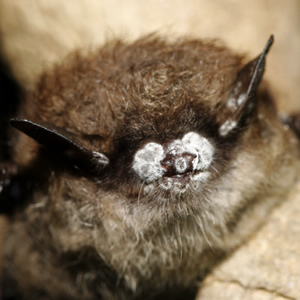What’s the Buzz?
Jordan Haber
31 March 2020
A colony of bats can dine on over a million-pest species in a single night and contribute billions of dollars’ worth of ecosystem services to agricultural industries. According to a recent study by biologists at the University of Guelph, in Ontario, Canada, however, an invasive species of fungus, P. destructans, threatens to put these ecosystem services at risk.
The Little Brown Bat (Myotis lucifugus) was once considered to be one of the most abundant vertebrate species in North America, but as a result of P. destructans, the Little Brown is now listed as endangered. These declines are significant, as Little Browns are known to consume over thirty species of insect pests, and according to the United States Department of Agriculture (USDA) the Little Brown contributes an estimated 20 billion dollars’ worth of pest management to cotton agro-ecosystems alone.
In 2006, scientist began to describe the first cases of the fungus in New York State. Biologists at the New York Department of Environment and Conservation claim symptoms can include white blotches of fungus around the bats’ body. These blotches can then prove fatal by forcing infected bats to wake up during hibernation to clear their nasal passages. Due to these disruptions, many infected bats don’t have the energy reserves to make it through winter and perish. Ecologist dubbed the condition White-nose Syndrome (WNS), and it’s believed that WNS is likely responsible for the collapse of entire bat colonies in the Northeastern US and Canada.

The Little Brown Bat above is infected with P. destructans as seen by the fungal growth and lesions in and around its nose and ears. The mortality rate for bats with WNS is projected to be between 95-98%.
As the fungus continues to spread, Farmers are worried that without bats such as the Little Brown, keeping pests like moths, hoppers, and mosquitos in check, crop yields will decline and human health will be put at risk. According to the 2019 University of Guelph study, however, as Little Browns decline, other bat species may be expanding their diet due to decreased competition.
According to the study, in post WNS sites, an increase in the populations of Big Brown Bats (Eptesicus fuscus) were observed. Big Browns, travel in much smaller colonies then Little Browns and are much more adaptable. For Instance, Little Browns, come back to the same roosting sites each day while Big Browns are more opportunistic.
While WNS deaths in Big Browns have been documented, mass die offs of Big Browns from WNS have rarely been observed. According to the study these differences in behavior, may be why Big Browns have shown resilience to WNS. As the Little Brown continues to disappear, more food is becoming available to the Big Brown, allowing it to increase its population in spite of the fungal epidemic.
It’s also worth noting that as their name suggests, Big Browns are also twice the size of Little Browns, and a single Big Brown can also eat more insects in a night than their smaller cousins.

Depicted above is a healthy Big Brown Bat (left) and Little Brown Bat (right).
Despite the optimistic outlook of the study, Gene Wingert, a life-long naturalist, and professor of Biology at Dickinson College, remains skeptical. When asked whether or not farmers should fear WNS, Wingert responded “while other bat species may be expanding their diet, they occur in far less numbers than the Little Brown, so farmers are likely to suffer”. Little Browns can roost in colonies greater than 30,000 strong, and according to Wingert “WNS is wiping out North America’s commonest mammal and it’s doing it in a hurry”.
References:
Morningstar, E. D., Robinson, V. C., Shokralla, S., Hajbabaei, M. 2019. Interspecific competition in bats and diet shifts in response to white-nose syndrome. Ecosphere: 10(11).

maricha
Great post! I had known about the plight of Little Browns, but I wasn’t aware of the role Big Browns play in this issue. I love that you were able to include a quote from Professor Wingert!
Lauren Kageler
A very interesting article that emphasizes one of the many benefits that the human population receive from the natural world.